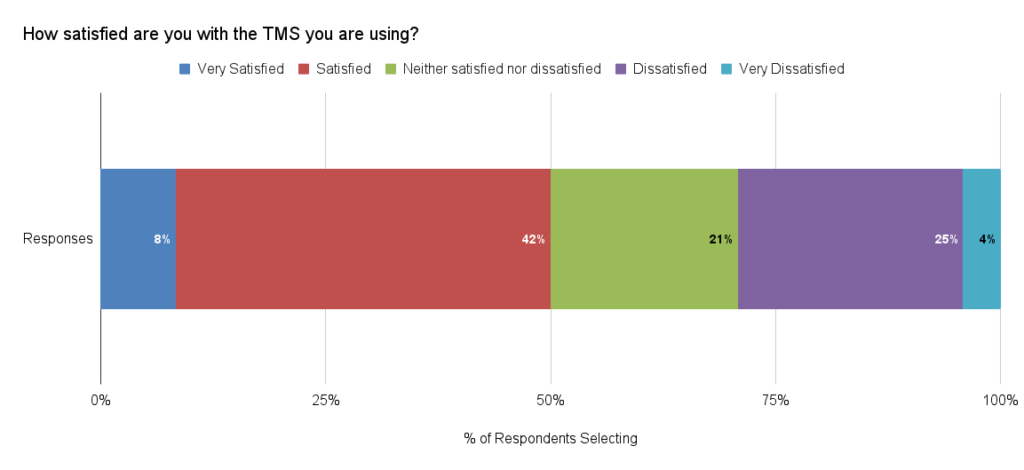Editor’s Note: The following is an excerpt of “Satisfaction with TMS Software,” a research report that highlights results from a survey conducted with members of Indago’s supply chain research community and JBF Consulting’s customer community. You can read the rest of the report and download a copy at JBF Consulting’s website.
The global transportation management systems (TMS) market size is estimated to be around $16-17 billion. But how satisfied are companies with their investments in Transportation Management Systems (TMS)? How do they measure/quantify satisfaction? As logistics software providers promote their Generative AI and Machine Learning capabilities, how satisfied are companies with the progress vendors are making in these areas?
We asked members of our Indago supply chain research community — who are all supply chain and logistics executives from manufacturing, retail, and distribution companies — as well as select members of JBF Consulting’s customer community, those questions in a recent survey.
Almost three quarters of the survey respondents (71%) are using a TMS, either deployed internally (50%) or provided by their 3PL (21%). Of the respondents using a TMS, half (50%) are either “Satisfied” (42%) or “Very Satisfied” (8%) with their solution. However, 29% said they were either “Dissatisfied” (25%) or “Very Dissatisfied” (4%) with their TMS.

So, what do these results tell us?
First, the results suggest that many companies are either not satisfied with their transportation management system or are neutral about it. Put differently, relatively few companies would say that they are “Very Satisfied” with their TMS.
What defines satisfaction? While none of the respondents have a “satisfaction” metric in place, when it comes to TMS, satisfaction is primarily driven by a solution’s ability to deliver cost and service benefits. “We measure TMS ‘satisfaction’ via traditional cost and service metrics,” said one logistics executive. Others shared similar comments:
“We have had very good success with our TMS. Cost control, service improvements, and productivity have been enhanced, which drive our satisfaction with the TMS.”
“Satisfaction from our end is really focused on its capabilities to improve workflow, reduce costs, and improve speed of delivery to customers.”
“We do not track a satisfaction metric. We do participate in periodic surveys and QBRs with our 3PL TMS provider. Biggest contributing factor towards satisfaction is cost-savings from shipment consolidation and on-time delivery tracking with carrier scorecards.”
What are some other important measurements companies use to quantify their TMS satisfaction level? What are the main reasons why companies are dissatisfied with their TMS? How satisfied are companies with the progress TMS vendors are making with their Generative AI and Machine Learning capabilities? For insights on those questions and more, please download the Indago report from JBF Consulting’s website. Also, watch the brief Indago ResearchCast video below for highlights.









